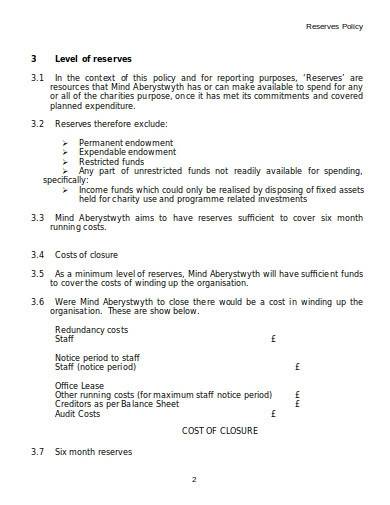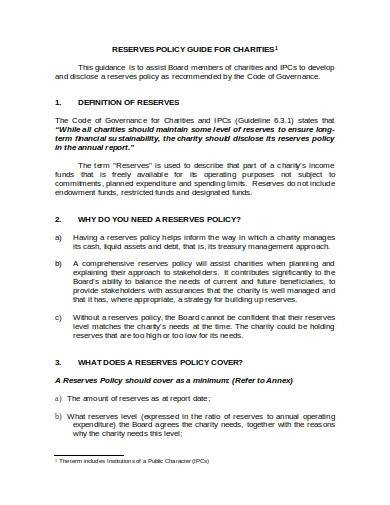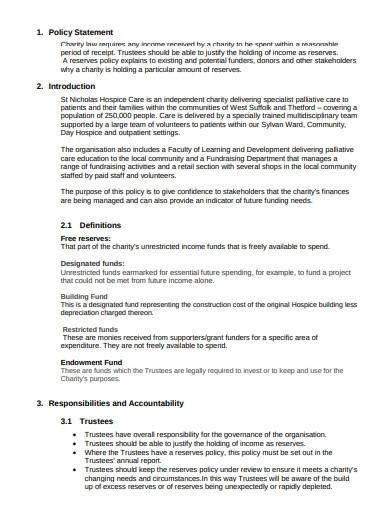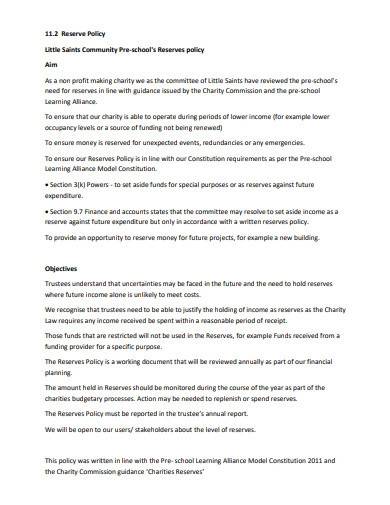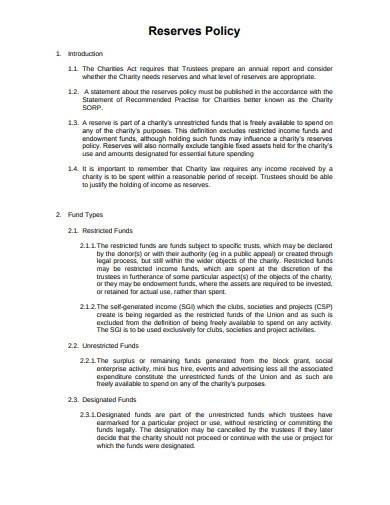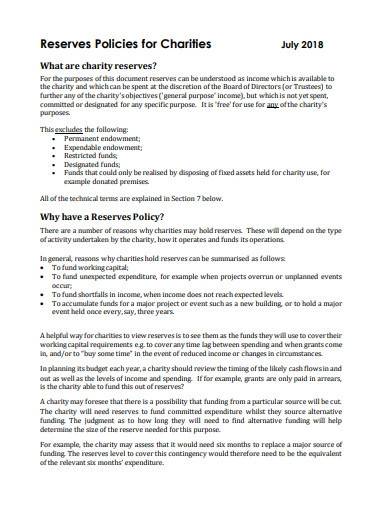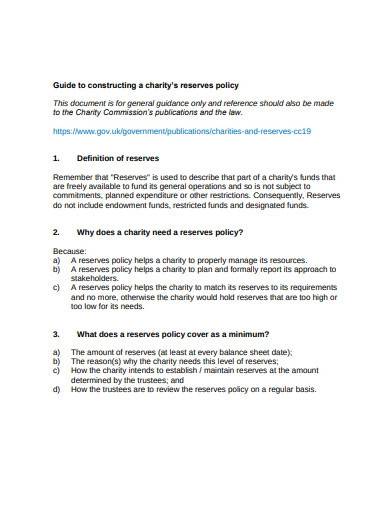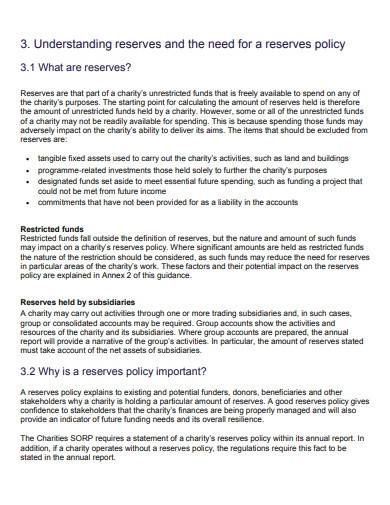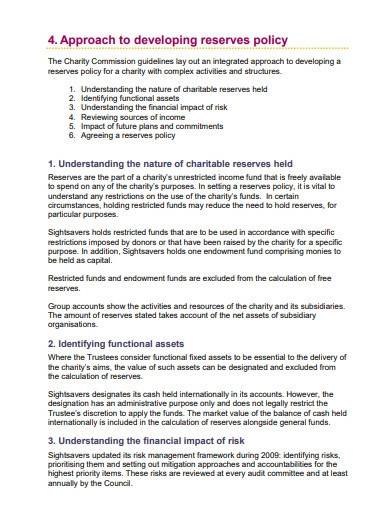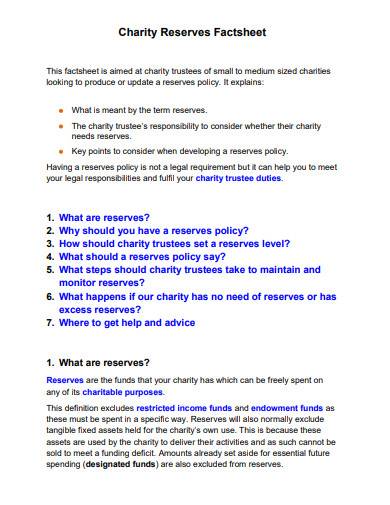All nonprofit and charitable organizations’ trustees have the role and responsibility to handle and manage their organizations in their best interest as well as their beneficiaries. These responsibilities include the management of the charity’s income, future management plans and development plans, running costs, and possible risks that the organization might encounter. As a part of its strategic planning, charities can maintain a reserve fund and establish their purpose for holding such assets in their reserve policy.
FREE 10+ Charity Reserves Policy Samples & Templates in MS Word | PDF
1. Charity Reserves Policy Template
2. Reserves Policy Guide for Charities
3. Simple Charity Reserves Policy Template
4. Charity Community Reserves Policy Template
5. Basic Charity Reserves Policy Template
6. Sample Reserves Policies for Charities
7. Standard Charity Reserves Policy Template
8. Charity Reserves Policy
9. Charity Fund Reserves Policy
10. Formal Charity Reserves Policy Template
11. Charity Reserves Factsheet Template
What is a Charity Reserves Policy?
Reserves refer to a part of a charity or nonprofit’s unrestricted funds that the organization can access to spend on any of its purposes. The charity’s reserves must exclude restricted funds and funds allotted for certain purposes as well as fixed assets that are not freely available to assist working capital requirements. A reserves policy for charities provides an explanation of why the organization is setting money aside instead of spending it to achieve its business goals. Other policies that charities follow include a charity pay policy, charity investment policy, charity privacy policy, charity marketing policy, charity recruitment policy, and more.
How to Write a Charity Reserves Policy
Reserves are considered to be an income that charities can access and spend at the discretion of their trustees to support the organization’s objective but are not yet spent, committed, or allocated for a certain purpose. Charity reserves exclude permanent endowments, expendable endowments, restricted funds, designated funds, and funds realized by disposing of fixed assets. With a reserves policy, charities can determine the level of reserves their organization should manage and hold.
Step 1: Decide on the Purpose of the Policy
This section contains the purpose of the organization’s reserve fund which is usually to help in ensuring its long-term ability to meet its mission statement. Other purposes can be to create an internal line of credit to handle the nonprofit’s cash flow and maintain flexibility, sustain operations, and pay for necessary expenses.
Step 2: Provide the Definitions and Goals
Provide the definition of the charity’s reserves fund than its goals and objectives. This section also includes details on the target minimum amount of the reserve and the designated amount as its beginning balance.
Step 3: Write the Sections for Shortfalls and Accounting for Reserves
Explain how the fund will be maintained and accessed. This will be in accordance with the organization’s risk preferences, liquidity requirements, and investment objectives. Create an effective plan for shortfalls and make sure to include the status of borrowings in the board’s financial reports.
Step 4: Provide Reasons for Using Reserves
Reserves will be accessed depending on how the management identifies their appropriate use. The organization’s executive director can access reserves given that they follow the process provided in the charity reserves policy.
FAQs
What are the reasons for holding charity reserves?
Charities hold reserves to fund and support working capital, to fund unexpected expenses for unplanned events, to fund shortfalls in income, and to collect funds for major projects or events.
What are the benefits of implementing a reserves policy?
With a reserves policy, charities can plan for their future activities or events, helps in ensuring that charities are using their funds to good effects, focuses on the charity’s fundraising activities, and is necessary to collaborate with external groups.
What information should be included in a reserves policy?
A charity reserves policy must state the reasons why the organization needs reserves, the level of reserves it needs, the steps the organization will take to establish and maintain the reserves, and the arrangements for reviewing and monitoring this company policy.
The charity reserves policy is one of the most essential policies that nonprofit organizations must include in their annual financial statements. This policy provides an explanation of why charities need reserves and their purposes. Reserve policies enable trustees to determine the level of reserves the organization should hold and help them decide whether it is appropriate for the charity to hold reserves.
Related Posts
Sample Corporate Sponsorship Letter
FREE 10+ Sample Donation Receipts in MS Word PDF
Sample Non Profit Proposal Template
FREE 9+ Donation Request Letter Templates in MS Word PDF
Program Evaluation Form
FREE 9+ Nonprofit Proposal Samples in PDF MS Word
Sample Donation Form
FREE 10+ Sample Donation Request Forms in PDF MS Word
Benefit Flyer Template
FREE 9+ Nonprofit Business Plan Samples in PDF MS Word
FREE 8+ Thank You Letter Samples in PDF MS Word
FREE 6+ Sample Fund-raiser Thank You Letter Templates in PDF
FREE 6+ Sample Thank You Letter For Donation in MS Word PDF
FREE 6+ Sample Donation Request Letter Templates in MS Word ...
FREE 8+ Sample Employee Performance Review Templates in MS ...

